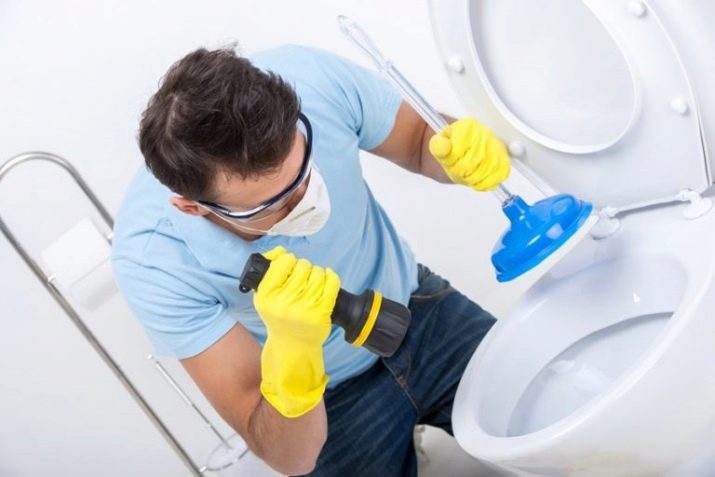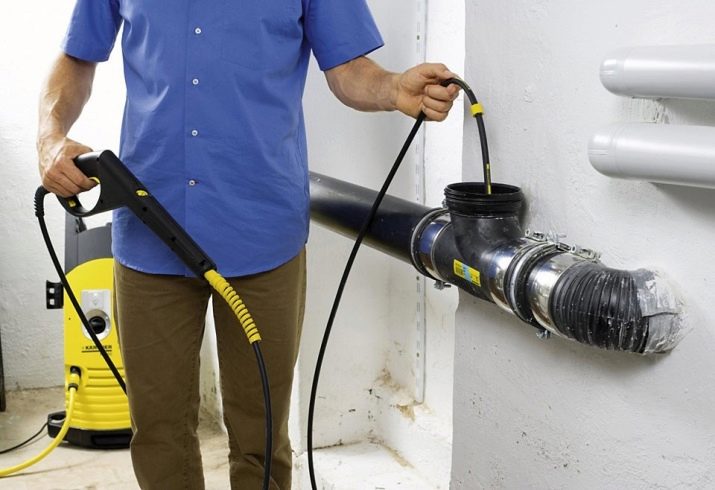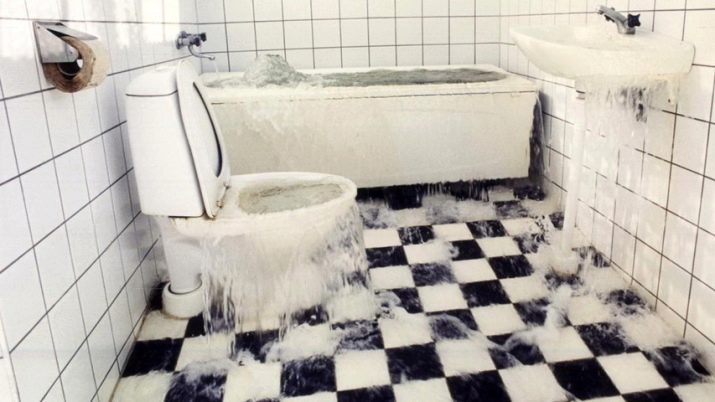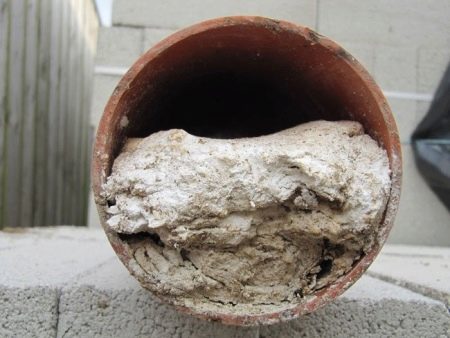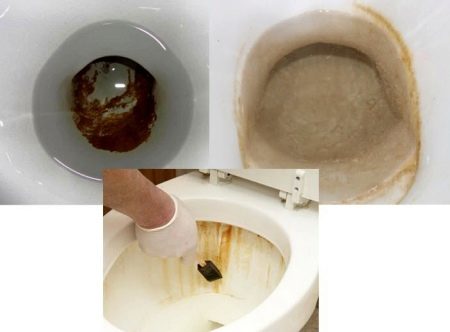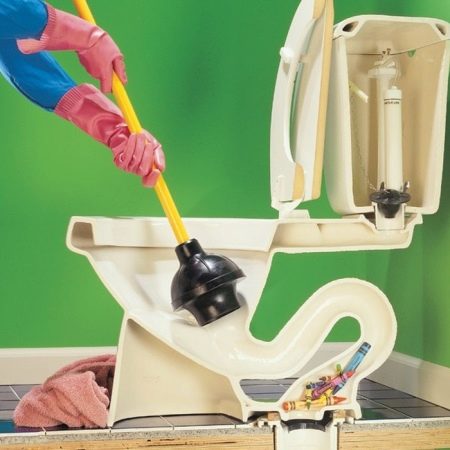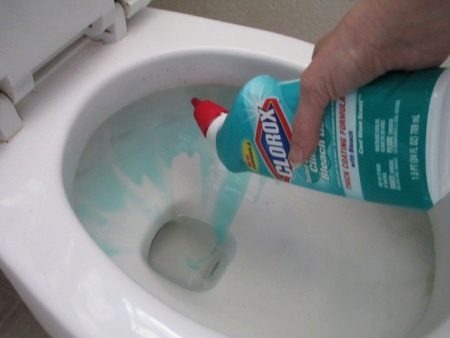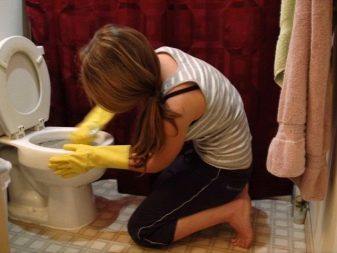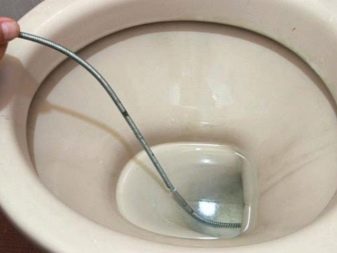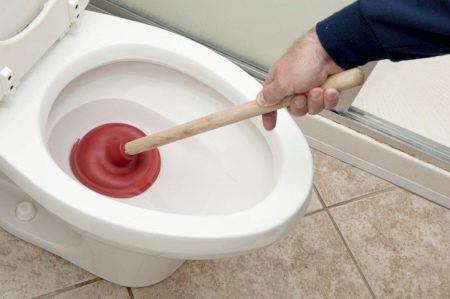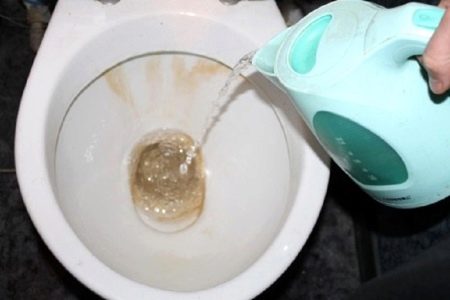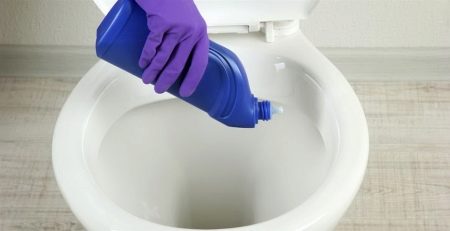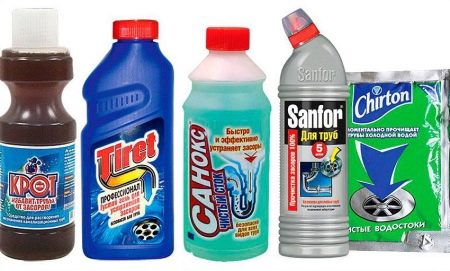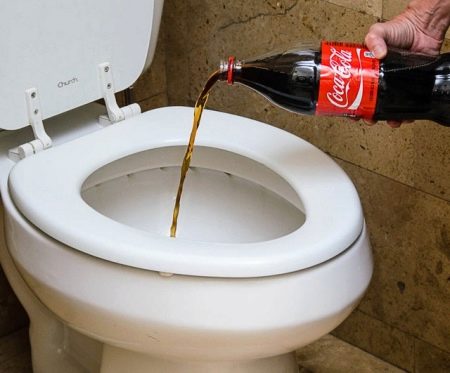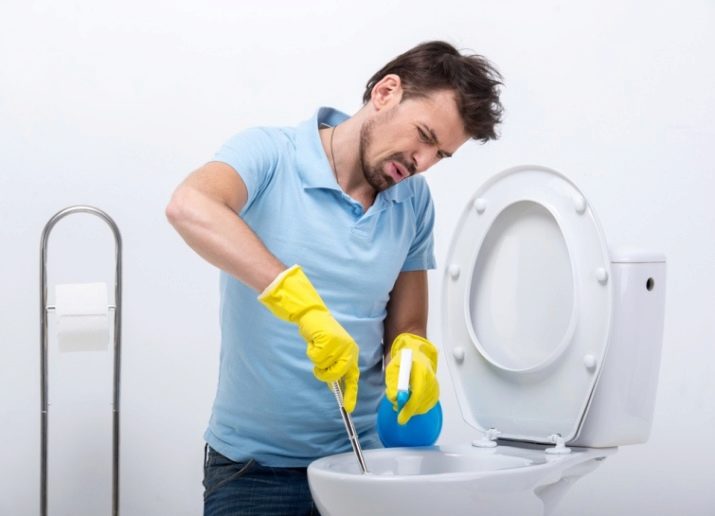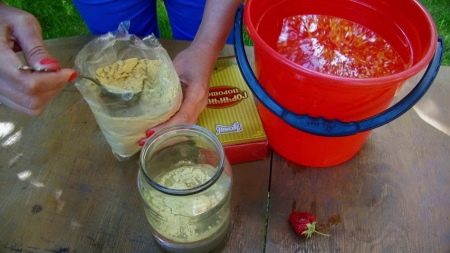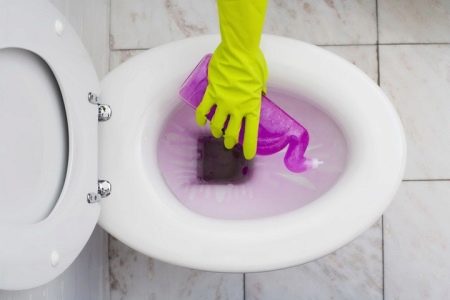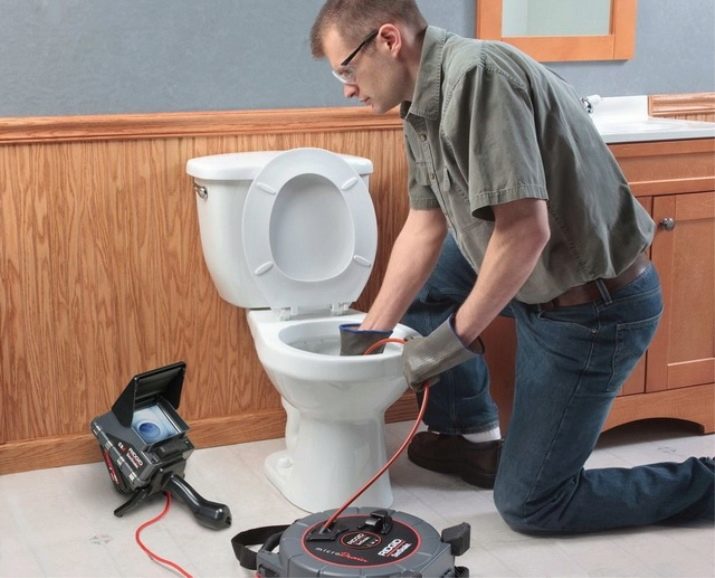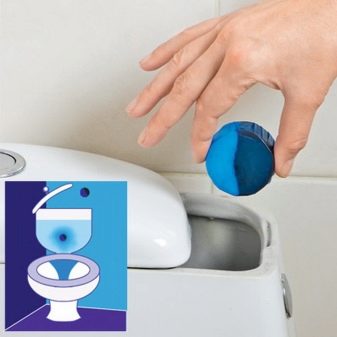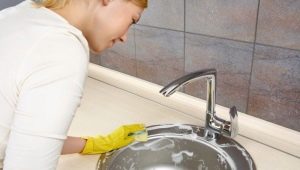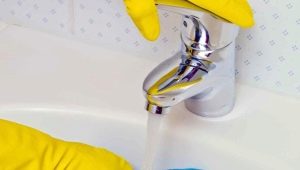How to clean the toilet: types of blockage and methods of troubleshooting
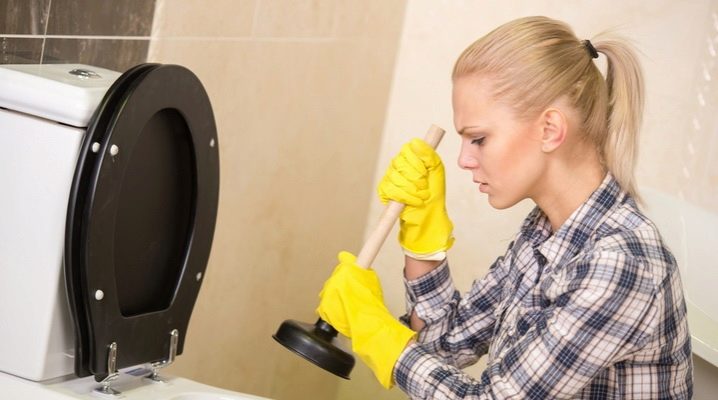
It is believed that life in a private house requires constant care from its owners for its various systems and communications. At first glance, living in an apartment building makes it possible not to think about such a need, after all, it is the concern of the housing department employees to monitor the serviceability and troubleshoot the systems. In fact, the residents of city apartments often face the problem of clogging the toilet.
The water does not go away, it rises in the bowl of the toilet bowl, an unpleasant smell appears - all these are “symptoms” of blockage. However, you can do it yourself.
Why is clogged?
The causes of clogging can be many, but if we talk about the nature of clogging, then there are only two reasons for this.
- Suddenly and sharply arising blockages appear as a result of objects entering into the drain hole, the dimensions of which exceed the diameter of the drain. Naturally, the object gets stuck, paralyzing the entire sewer system. Often such objects are textiles, food waste, hygiene items or solid products, voluntarily or involuntarily flushed into the toilet.
- Chronic blockages usually occur gradually. First, there is a difficulty in the outflow of water, which, more and more aggravated, turns into a complete absence of outflow. The reasons for this blockage are organic (fat, hair) and inorganic (salt, scale contained in water) deposits.
Before dealing with a blockage, you should try to establish its cause, because the choice of the method to remove the blockage depends on it. As a rule, recalling the latest events of the day, it is possible to establish whether the problem is caused by the ingress of foreign objects into the drain channel.
What problems arise?
Clogging the toilet is an unpleasant problem, which can be understood as several types of incorrect operation of the sewer system. As long as this problem does not affect a specific user, he may not think about it, and at the mention, even with a grin, recall the words of the song about a pierced "through blue toilet". However, no one is able to fully insure against this trouble that usually arises unexpectedly.
Clogging can manifest itself by slowing down or disrupting the outflow of water from the toilet bowl when flushing, by raising the level of sewage in the inlet pipe, by the appearance of an unpleasant smell and gurgling sounds, by screaming in the pipe. With all these difficulties you can cope on your own. If there is no possibility or desire to eliminate the blockage, you can invite a specialist from the housing department. Such situations are not critical, so you can wait for him to come within a few hours or a day or two.
Severe clogging manifests itself by raising the level of sewage to such an extent that they pour out of the toilet bowl. Evidence of the criticality of the situation is the broken valve on the common pipe. In this case, you need to immediately call the emergency service, and before they arrive, block the riser.
Often water is collected in the toilet bowl or other faults appear due to improper sewer design. This may be sagging and freezing of pipes, too sharp bends in inappropriate places. As a rule, the problem is not immediately detected, but after some time of operation. Solve the problem quickly and exclusively on their own is unlikely to succeed. The only way out is to dismantle the system, correcting errors.
Sometimes there is a question or you can clog the sewer with toilet paper.The answer is negative, since modern products are completely dissolved in water. However, it is impossible to say the same about ordinary paper for writing, drawing, and also newspapers. The pulp entering into them swells up under the influence of moisture, after which even a small lump of paper increases by 2–3 times and runs the risk of getting stuck in a pipe.
It is unacceptable to drain the fat and used oil from the pans, as it settles on the walls of the pipes, eventually turns into a cork. Poured into the toilet, the sleeping tea in the pipes turns into a real “cement” - the welding is clod and compacted. It is unacceptable to flush to the toilet hygiene items, diapers, packaging film and plastic bags. Whoever flushes these things down the toilet should not be surprised that he is clogged.
One of the reasons why water does not leave the bowl is the growth of the urinary stone. It appears on the surface of the toilet bowl and sewage pipes due to stagnant urine in the device. This may be due not only to the fact that users do not press the drain button after urination, but also for other reasons. So, leaking tank contributes to the spread of mineral deposits. Defective or outdated plumbing with damage is also susceptible to urinary stone attack. In the cracks, scratches, grooves accumulate remnants of urine and bacteria.
The urinary stone is not only an aesthetic problem, but also a serious threat to the integrity of the lumen of toilet tubing. The fact is that expanding, deposits close this gap. It is possible to get rid of a urinary stone in the mechanical or chemical way.
Could it be that the toilet is clogged because of the neighbors? If you live in an apartment building, it can. This is due to the characteristics of the organization of the sewer system. The sewer riser is common to all residents of the house (the “line” of apartments one above the other from the first to the last floor), from each apartment a main outlet is connected to it. The diameter of the total riser - no more than 100 mm.
If the blockage goes beyond the trunk pipes of your neighbors, but does not fall along the riser, sooner or later a traffic jam will form in this place. Another option for the development of unpleasant events - in the siphon toilet neighbors got a foreign object. Instead of pulling it out, they pushed it into a common riser, where the foreign thing was stuck.
Evidence of a blockage of the total riser at the apartment level above or below the floor is a gradual increase in the water level in the toilet. That is, it rises by itself. Eliminate such a clogging yourself will not succeed, you need to promptly call the emergency service. To remove the blockage, the plumber will use a long cable or other device that can reach the blockage point. In more advanced cases, resort to dismantling the pipe.
What to clean?
The variety of cleaning methods can be divided into two groups.
- Mechanical. As a rule, they involve the use of a plunger and a cable, as well as other devices. This method is suitable if an object is stuck in the sink. The use of various liquids to eliminate blockages is useless, because they can not dissolve, for example, a stuck apple or rags.
- Chemical. Effective in the formation of blockage caused by sediment in the sewer pipe. The principle of operation of such agents is based on a chemical reaction, during which the blockage dissolves.
In some cases, only a combination of these methods can cope with the problem. As a rule, this applies when a foreign object gets stuck in pipes that have a deposit. Pushing it with improvised means or cables does not help, so dissolve deposits first. As a result of chemical exposure, the diameter of the pipe becomes the same (that is, it increases compared to what it was at the time of the jam), and the object passes through the pipe.
It is necessary to dwell on each of the methods.
Mechanical cleaning is effective if the toilet doesn’t drain well, which is caused by a foreign object getting stuck in the pipe no further than the siphon. Armed with long gloves, a scoop and a bucket, you can begin to diagnose the problem. Your task at this stage is to extract water from the toilet bowl to the maximum. After that, hand gently examine the siphon space. Soft objects can be removed by hand, solid - to get the wire, after bending its end.
You can try to clean the toilet bottle. The principle of action is based on the capabilities of the water hammer, with which the stuck object is pushed into a wider pipe. To implement this method, take a bottle whose diameter coincides with the diameter of the toilet bowl. Cut the bottom of it, tighten the neck cap. Start to slowly sink the device into the toilet until you feel the air resistance. At this point, sharply press the bottle even deeper into the toilet, and then quickly pull it out.
Such actions must be performed several times until the desired result is achieved.
After the first water hammer, it may seem that the situation remains unchanged. However, with each new manipulation, the object gradually moves towards a pipe of a larger diameter. That is why you need to make a "series" of water hammer. If there was no bottle on hand, use a stick or a mop on which rags are wound. The diameter of the resulting winding should correspond to the diameter of the inlet drain of the toilet bowl. The process is performed in the same way as when using the bottle.
A specialized tool for creating water hammer is a plunger. Unlike self-made counterparts, it does not need to be placed in a release hole. On the contrary, the diameter of the plunger must exceed the diameter of the hole. With this tool, a vacuum is created, and then a hydraulic shock, with which it is possible to remove the blockage. The procedure will be more effective if during the time it is held to close the drain and overflow holes of plumbing in the bathroom and in the kitchen.
A blaster for the sink, bathtub and toilet bowl will also allow you to create a hydrodynamic shock. This device is equipped with a piston, through which air is pumped into the blaster, high pressure is generated. After that, you should attach the unit to the drain hole, press the start button. Convenience of the device is that it has several nozzles for different diameters of the drain hole, therefore it is universal.
Another tool used by both professionals and ordinary people is a flexible plumbing cable. Made of metal, it has a spiral tip with a point, thanks to which it breaks through a solid layer of sediment. The cable should be smoothly introduced into the drain channel, while making rotational motion. (The device has a handle, so it is convenient to use it).
Having broken through a blockage, it is necessary to make back and forth movements in order to get rid of deposits on the pipe walls and to increase its internal diameter. Fully fix the problem plumbing cable can not. This tool is an “first aid” for blockages. After the outflow has been restored, the sewer pipes should be cleaned with chemicals.
If you didn’t have a bottle, a plunger, or a cable on hand, you can try to create a water hammer using cling film. To do this, fold it 3-4 times to increase its strength. After that, the film is sealed with adhesive tape around the entire circumference of the toilet lid. You have to stretch the film from one edge of the toilet lid to the other, fix the cloth with duct tape.
After that, water is drawn into the toilet bowl until it begins to touch the film. Now you need to repeatedly press on the surface of the film, provoking the occurrence of water hammer.Actions should be repeated until the blockage is broken through or until it becomes clear that in your case the method is ineffective.
In general, any object at hand can help break through the blockage. There are a lot of stories in the network, as they did with a stick, a lath, even a fork. In this case, an improvised probe should not just be pushed forward, but rotated in order to quickly break the cork.
Chemicals can be shop and homemade. The simplest way to clean the toilet from sediment is boiling water. It is necessary to pour it into the toilet sink. This method is effective only if the blockage is caused by the formation of a fat tube in the pipe. Boiling water will allow it to dissolve, and the water will start to leave. Pour boiling water at a right angle, quickly.
This method helps in limited cases, but it will not be superfluous to apply it. You can add a little soda to the boiling water or pre-pour into the toilet ¼ a portion of a bottle of dishwashing detergent. It is unacceptable to pour boiling water into the toilet, if it has a thin connecting corrugation. In this case, just enough hot water.
The simplest chemical way to solve the problem is the method based on the alkaline reaction of vinegar with soda. It is necessary to extract water to increase the concentration of the composition. After that, a pack of soda is poured into the drain hole. It should give her 15-20 minutes to soda settled on the surface of the pipe and clogging. After the indicated time, 200 ml of vinegar 9% is poured. As a result of a chemical reaction, it is sometimes possible to break through a blockage in its most subtle place.
If necessary, the procedure is repeated, but not more than two times. If after double use of soda with vinegar positive results have not appeared, it is worth looking for other methods.
It is believed that solutions based on corrosive acids are most effective. They really eat away the blockage, and with it the surface of the sewer pipes. Use these recipes should be with caution and only if the entire sewage system is cast iron. In the store, you can purchase products based on weakly concentrated acids. They can be in the form of a gel, powder, tablets.
Among the most popular emit funds such as "Mole", Tiret, "Mr. Muskul", "Flup" (has the form of granules). When using them, you should protect your hands with gloves, to prevent the composition from getting on the mucous membranes and skin. The tool is poured or poured into the drain according to the instructions. After a time recommended by the manufacturer, you should flush the toilet with plenty of water.
Please note that not every tool is suitable for breaking through a blockage if a porcelain toilet is installed in the apartment.
On the Internet you can find a lot of original ways of cleaning the clogging with Coca-Cola. However, this drink will help in the fight with a slight coating on the surface of the toilet bowl. Break through the blockage is beyond his power. The cleaning method is also ineffective. It can be used as a preventive measure against plaque and no more.
One of the reasons for the blockage is an overgrown urinary stone. It can be removed mechanically by draining water and simply cutting off deposits and cleaning the surface with a hard brush. However, this method is practically not used, because after it the surface of the toilet bowl is covered with cracks and chips.
It is much more convenient and safer for sanitary coatings to use store "chemistry". “Mr. Muskul” in granules, Domestos Pink gel (designed specifically to combat blockages) and “Toilet duckling” demonstrated their effectiveness in the fight against significant growths of urinary stone.
It is important to follow the instructions, to comply with the accuracy of the time of exposure of the drug. Otherwise, you can get an unpredictable cleaning result.
As for folk methods, they exist. And sometimes they surprise with their radicalism. An effective means of metal pipes is the use of automotive electrolyte for the battery. First of all, you need to drain the toilet bowl, then pour the electrolyte on the problem area and leave for 1.5 hours. After a specified period of time, the raid is cleaned by a brush (it should not be non-metallic).
More conservative but also effective ways is cleaning with citric acid or bleach (in powder form). To do this, pour a packet of bleach or 4 packs of citric acid into the toilet bowl drain, leave it overnight, then rub the deposits with a brush and rinse with water.
How to clean yourself?
Not being able to contact the housing office or third-party specialists, many are forced to look for ways to clean at home, that is, independently. However, it will not always be possible to do this — it is possible to eliminate the blockage with your own hands if it was formed directly in the toilet channel. If the problem has touched all the points of discharge, it is necessary to seek help in the housing department.
You can determine the location of the blockage by turning on the water in the bathroom and the sink in the kitchen; if it goes away without difficulty, you can try to clean the toilet yourself.
Quickly and effectively, a small blockage can be removed with hot water and mustard. In 10 liters of heated water, dissolve 5 tablespoons of dry mustard. Quickly pour the composition into the toilet, and after 10 minutes, try to flush. If necessary, repeat the manipulation 2-3 times.
So, starting to eliminate the blockage, you should do the following:
- make sure the blockage is local. Otherwise, call "emergency gang";
- determine the location of the blockage (no further than the toilet siphon);
- try to determine the nature of the blockage and the reason for its occurrence;
- If foreign objects enter the pipe, try to remove them by hand. At the same time, pull the object back into the apartment, and not push it into the common riser;
- When overgrowing tubes with build-up, use chemical cleaners using store or traditional methods. When carrying them out, protect your hands and respiratory organs;
- If the blockage occurs as a result of the simultaneous entry of a foreign object into the pipe and a decrease in the diameter of the drain due to the growth of deposits, the pipe should be cleaned in a combined way. This should be done by pouring in a chemical agent. After the deposits are dissolved, it will be easier to get the item in one of the mechanical ways.
If none of the methods have yielded a positive result, call a plumber. Clogging can be associated with improper installation of pipes or toilet. In any case, a professional will establish the cause and eliminate the blockage. It is not recommended to use the toilet at the time of blockage - this will aggravate the situation.
Tips and tricks
Regular prophylaxis will reduce the risk of blockages. First of all it is necessary to ensure that no foreign objects get into the channel.. Do not pour into the toilet spoiled food, food waste and hygiene products. If you pour out the water after cleaning, make sure that there are no rags, a bar of soap or other large items left in the bucket.
Water can be blocked by cat litter and various litters for domestic rodents. Basically, they have wood or more modern materials that absorb moisture. It is easy to imagine what will happen to sawdust that fell into the water. They simply take it in themselves and significantly increase in volume. So much so that they can fill the diameter of not only the trunk, but also the total riser.
If folk remedies, like other methods do not allow to solve the problem, it is better to call the housing office and ask to send a master. Plumbing should also be called if the blockages occur constantly for no apparent reason (that is, the plumbing operation rules are not violated).Pipes can be mounted incorrectly or they have a period of operation coming to an end. Replacing the pipes and changing the way they are installed will allow you to forget about blockages.
Every three months, fill the toilet with tools that eliminate limescale and deposits from the surfaces of sewer pipes. And once a week you can resort to preventive cleaning with boiling water. To prevent the formation of urinary stone growths will allow daily cleaning of the toilet, as well as flushing with each user. Flush must be done with plenty of water.
It is also useful to purchase special tablets for the toilet bowl and helium blocks, which are mounted under the rim of the toilet bowl.
Interestingly, the rough surface of the toilet bowl is prone to the appearance of growths, while owners of glossy models of sanitary ware face this problem less often. It is also possible to single out the following measures for the prevention of the formation of sewer obstruction:
- prevent the formation of rust and deposits on the surface of the toilet bowl and pipes;
- prevent leakage of pipes, cistern and other sewage elements;
- eliminate small blockages in the first stages of their appearance.
How to clean the toilet from clogging, see the following video.

